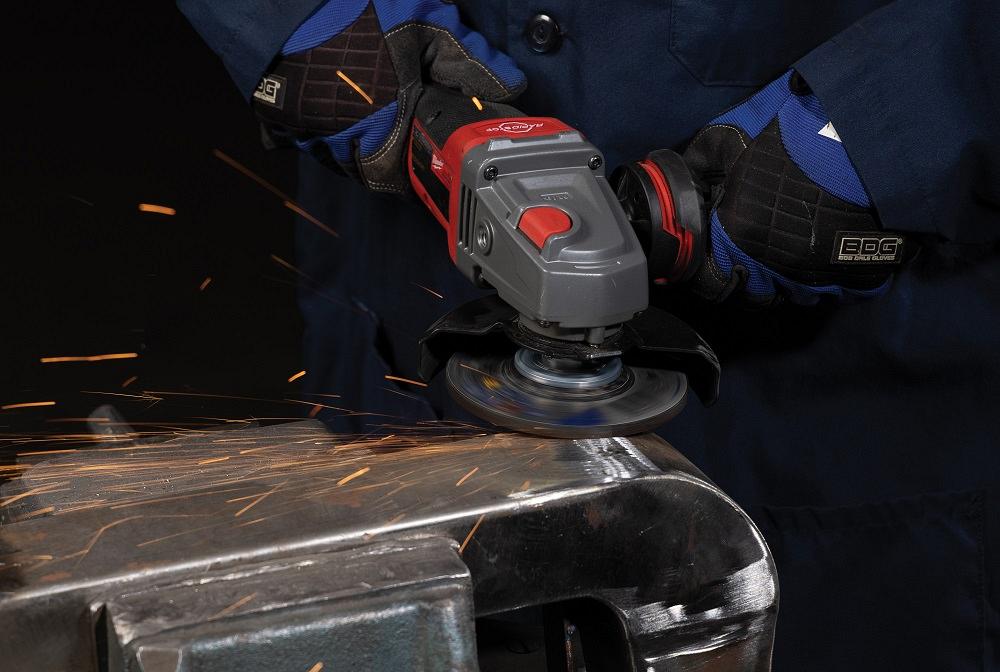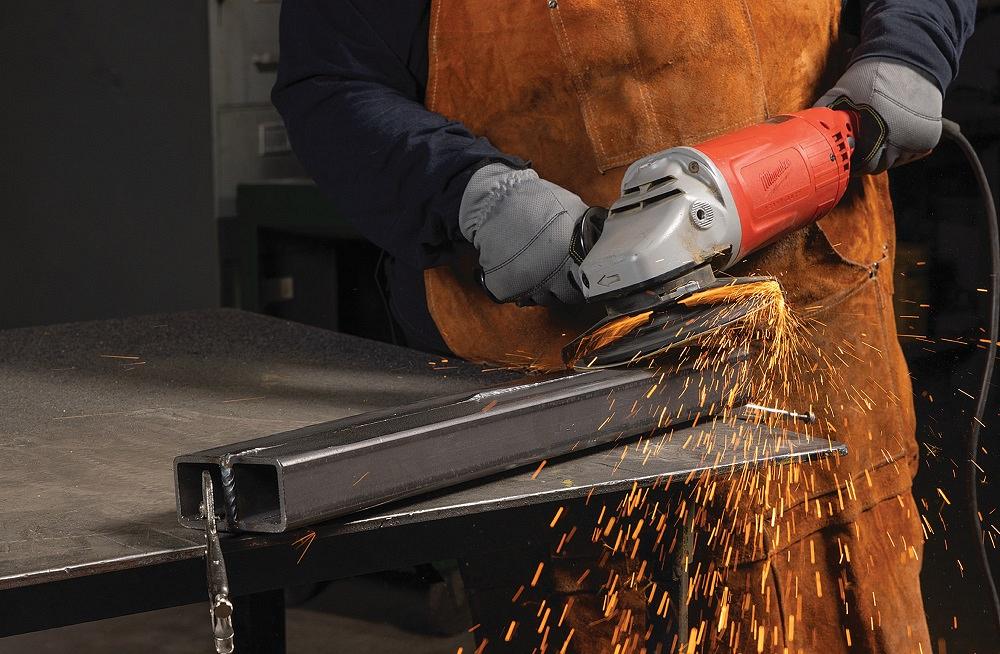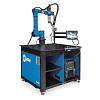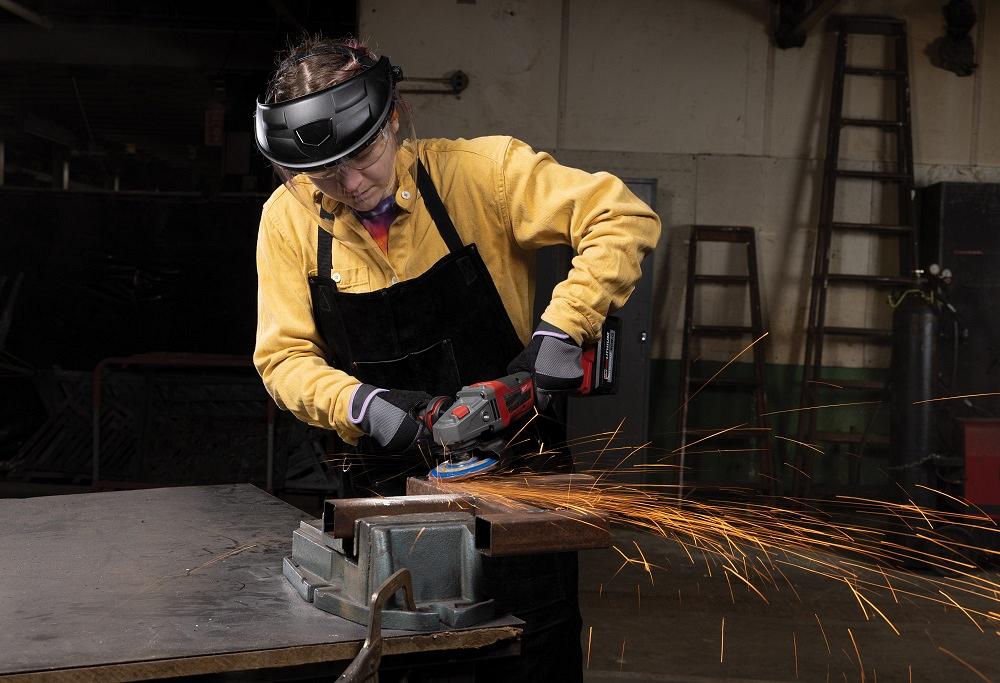Editor
- FMA
- The Fabricator
- FABTECH
- Canadian Metalworking
Categories
- Additive Manufacturing
- Aluminum Welding
- Arc Welding
- Assembly and Joining
- Automation and Robotics
- Bending and Forming
- Consumables
- Cutting and Weld Prep
- Electric Vehicles
- En Español
- Finishing
- Hydroforming
- Laser Cutting
- Laser Welding
- Machining
- Manufacturing Software
- Materials Handling
- Metals/Materials
- Oxyfuel Cutting
- Plasma Cutting
- Power Tools
- Punching and Other Holemaking
- Roll Forming
- Safety
- Sawing
- Shearing
- Shop Management
- Testing and Measuring
- Tube and Pipe Fabrication
- Tube and Pipe Production
- Waterjet Cutting
Industry Directory
Webcasts
Podcasts
FAB 40
Advertise
Subscribe
Account Login
Search
How welders can stay safe during grinding
The FAQs about abrasives safety
- By Rafael Guerrero
- April 24, 2024
- Article
- Finishing

Advancements in abrasives technology have made processes like grinding safer. Nonetheless, grinding can be dangerous if operators don’t follow safety instructions, procedures, and requirements. Images: Norton | Saint-Gobain Abrasives
Safety is at the heart of many advancements made in abrasives technology.
Innovations such as right-angle grinders with internal vibration-reduction systems and vibration-dampening gloves are designed to reduce stress on the operator, and more improvements are still to come.
“Emerging technology is on the horizon that will help operators manage the grinding vibration they receive by using wearable devices that monitor operator vibration exposure and help identify exposure thresholds,” said Adam Bujnowski, senior product safety engineer for Norton | Saint-Gobain Abrasives. “These significant improvements could have a tangible impact on an operator’s long-term safety.”
But innovations won’t solve every safety concern associated with grinding. It can still be a dangerous process for operators who don’t know what they are doing or ignore safety requirements and product safety procedures. In this interview with The Welder, Bujnowski goes back to some basics and answers questions regarding abrasives safety, red flags, storage strategies, and personal protective equipment (PPE).
The Welder: What are the most common questions you receive about abrasives safety?
Adam Bujnowski: The typical questions we commonly answer revolve around correct wheel usage. Am I using the right wheel, disc, or belt for the job? What is the correct operating speed? What is the product's shelf life? Occasionally, a person wants to do something with the product or grinder that does not comply with ANSI or OSHA.
Fortunately, all these questions can be answered by contacting your manufacturer or Norton | Saint-Gobain Abrasives. Manufacturers develop abrasive grinding products to perform specific tasks on various materials, so reading and understanding the safety warnings is critical. Before use, follow the safety guides provided with the abrasive product and the operation guide supplied with the grinder.
TW: What PPE should operators use when grinding? Why?
AB: Most abrasive wheels, discs, and belts rotate at high speeds to effectively perform grinding. As a result, accidental contact with one of these products during operation may result in a critical injury. One of the most important factors for safe grinding includes wearing appropriate PPE such as ANSI-rated eye and face protection, hearing protection, respiratory protection (type based on the material being ground), a protective leather or Kevlar apron, cut-resistant gloves, and safety shoes. One common issue in the field is operators wearing welding masks and helmets that are not impact rated to ANSI Z87.1, Current Standard for Safety Glasses. Be sure the PPE you wear is of the correct type and rating.
TW: What common injuries can result from not using right-angle grinders properly?

Manufacturers develop abrasive grinding products to perform specific tasks on various materials, so reading and understanding safety warnings is critical.
AB: When right-angle grinders are used properly with the correct protective equipment and guarding, they are very safe and efficient tools. However, if grinders are misused and PPE guidelines are not followed, they can cause severe injury.
Fractures and lacerations to the hands, face, and eyes are the most common. Long-term effects of vibration from powered hand tools include hand-arm vibration syndrome and back and shoulder injuries resulting from strain and overuse. To minimize risks, be mindful of grinding ergonomics and take breaks during long stretches of operation. Prevent accidental startup of the machine during abrasive wheel changes or equipment repair and maintenance by disconnecting it from its power source.
TW: What should be inspected on a wheel before use? Any red flags to keep an eye out for?
AB: Check all wheels for cracks or damage before use, as sometimes wheels can be damaged in storage. Don’t exceed the speed marked on the grinding wheel. Check the grinder's maximum operating speed against the established safe operating speed marked on the wheel; overspeed is the No. 1 leading cause of wheel failure. Use the side handle furnished with the grinder. Use all wheels at the proper grinding angles marked on them. Follow all symbols and warnings located on the wheel.
Review all applicable safety datasheets before using the product. Comply with ANSI B7.1, OSHA, and all safety materials provided with wheels and grinding tools. Don’t use wheels that have been dropped or otherwise damaged. And always handle and store grinding wheels carefully.
TW: What about the grinders? What should be inspected before and after use? What is an ideal maintenance schedule for this equipment?
AB: Check your guard for wear or damage, and make sure you have the correct size and type of guard on your right-angle grinder. For example, if you have a type 1/41 wheel on your grinder, make sure the guard is suited to that cutoff wheel.
If your grinder comes with a side handle, it was designed to be used with two hands. Always inspect your machine's auxiliary handle to ensure it is attached and adequately tightened, secure your workpiece, and use both hands on the grinder. And if possible, for best practices, measure the spindle on the machine with a tachometer once a month. Run the wheel in a protected area, such as an empty 50-gal. steel drum, for one minute before grinding. Always maintain your tools as if your life depends on them.
TW: Is there ever a time to remove or adjust a guard from its intended position on a tool?
AB: Most abrasive products (with some exceptions) require a guard. Guards have many functions, such as protecting the operator from an abrasive product’s breakage, deflecting sparks, collecting dust and swarf, and keeping body parts from encountering rotating abrasive products.
Always use the wheel guard furnished with the grinder, properly adjusted. A wheel guard set too high on a portable angle grinder will allow the wheel to hang below the guard. This improper setting may render the guard useless in the event of a wheel breakage. On portable machines, position the guard so it is located between the operator and the grinding wheel. Make sure no bystanders are in front of the wheel guard’s open area to prevent injury if the wheel breaks.
If a wheel does break, inspect the guard and replace it if there is any sign of damage. Using a damaged wheel guard is extremely dangerous to the operator's and bystanders' safety. Guards that are cracked, deformed, bent, or severely worn may become ineffective in protecting against wheel breakage and must be replaced.
TW: How should shops store abrasive products so they remain safe to use?
AB: Wheels, fiber discs, quick-change discs, and coated products such as belts and sanding discs must be appropriately stored while not in use. Store them where they will not be exposed to water or other solvents, temperature or humidity conditions that cause condensation, or freezing temperatures. Arrange abrasive products storage to allow for removal without damage to adjacent products. Storage also should enable use on a rotational basis to minimize the possibility of damage from lengthy storage. Remove abrasive products from portable sanders/grinders for overnight storage and while moving the machines from one work site location to another.
Also use care for short-term storage during the regular work shift, such as placing the machine down to do other tasks. Never allow the wheel or machine to drop onto the floor, because impacts from such abuses can damage or break the wheel. Additional information regarding proper wheel storage can be found in ANSI B7.1, Safety Requirements for the Use, Care and Protection of Abrasive Wheels.
About the Author

Rafael Guerrero
2135 Point Blvd.
Elgin, IL 60123
(815)-227-8242
Rafael Guerrero. was named editor of The Welder in April 2022. He spent nine years as a journalist in newspapers in the Midwest and Pacific Northwest, covering topics and communities in central Illinois, Washington, and the Chicago area.
About the Publication
Related Companies
subscribe now

The Welder, formerly known as Practical Welding Today, is a showcase of the real people who make the products we use and work with every day. This magazine has served the welding community in North America well for more than 20 years.
start your free subscription- Stay connected from anywhere

Easily access valuable industry resources now with full access to the digital edition of The Fabricator.

Easily access valuable industry resources now with full access to the digital edition of The Welder.

Easily access valuable industry resources now with full access to the digital edition of The Tube and Pipe Journal.
- Podcasting
- Podcast:
- The Fabricator Podcast
- Published:
- 04/30/2024
- Running Time:
- 53:00
Seth Feldman of Iowa-based Wertzbaugher Services joins The Fabricator Podcast to offer his take as a Gen Zer...
- Trending Articles
Aluminum MIG wires offer smooth feeding, reduced tangling

The role of flux in submerged arc welding performance

Three ESAB welding machines win Red Dot Awards for product design

Power source added to cobot welding system for simplified automation

Connecticut students compete in Maritime Welding Competition

- Industry Events
Pipe and Tube Conference
- May 21 - 22, 2024
- Omaha, NE
World-Class Roll Forming Workshop
- June 5 - 6, 2024
- Louisville, KY
Advanced Laser Application Workshop
- June 25 - 27, 2024
- Novi, MI
Precision Press Brake Certificate Course
- July 31 - August 1, 2024
- Elgin,



























